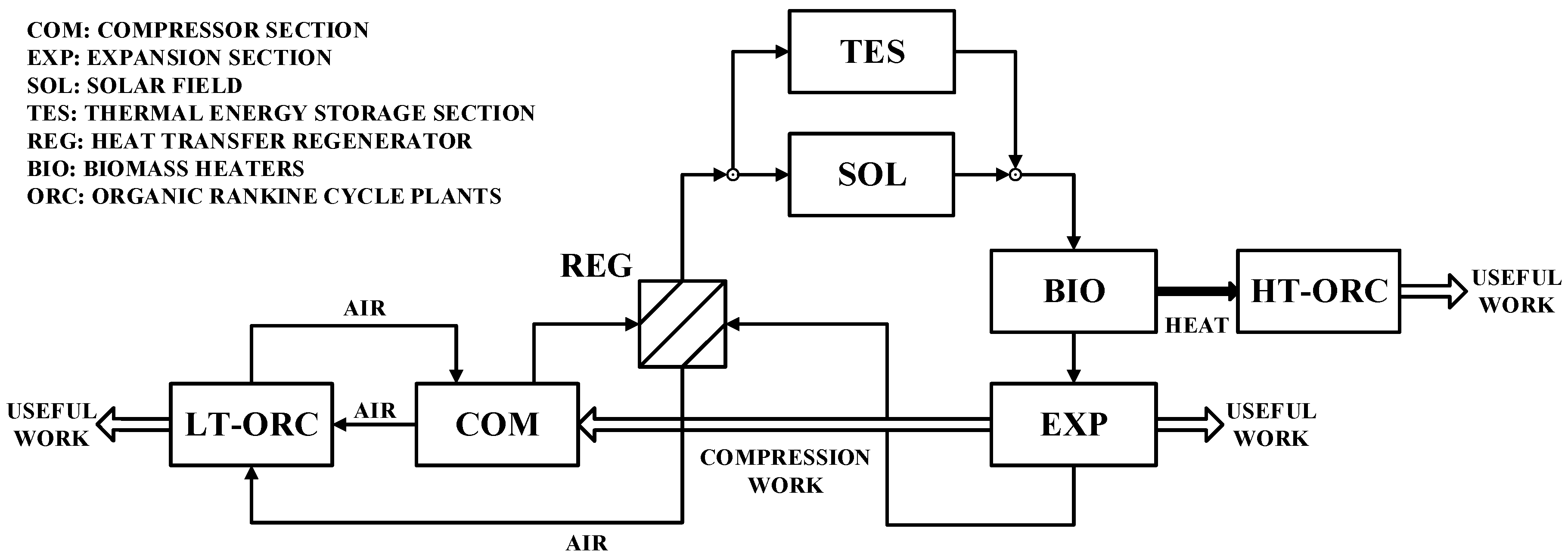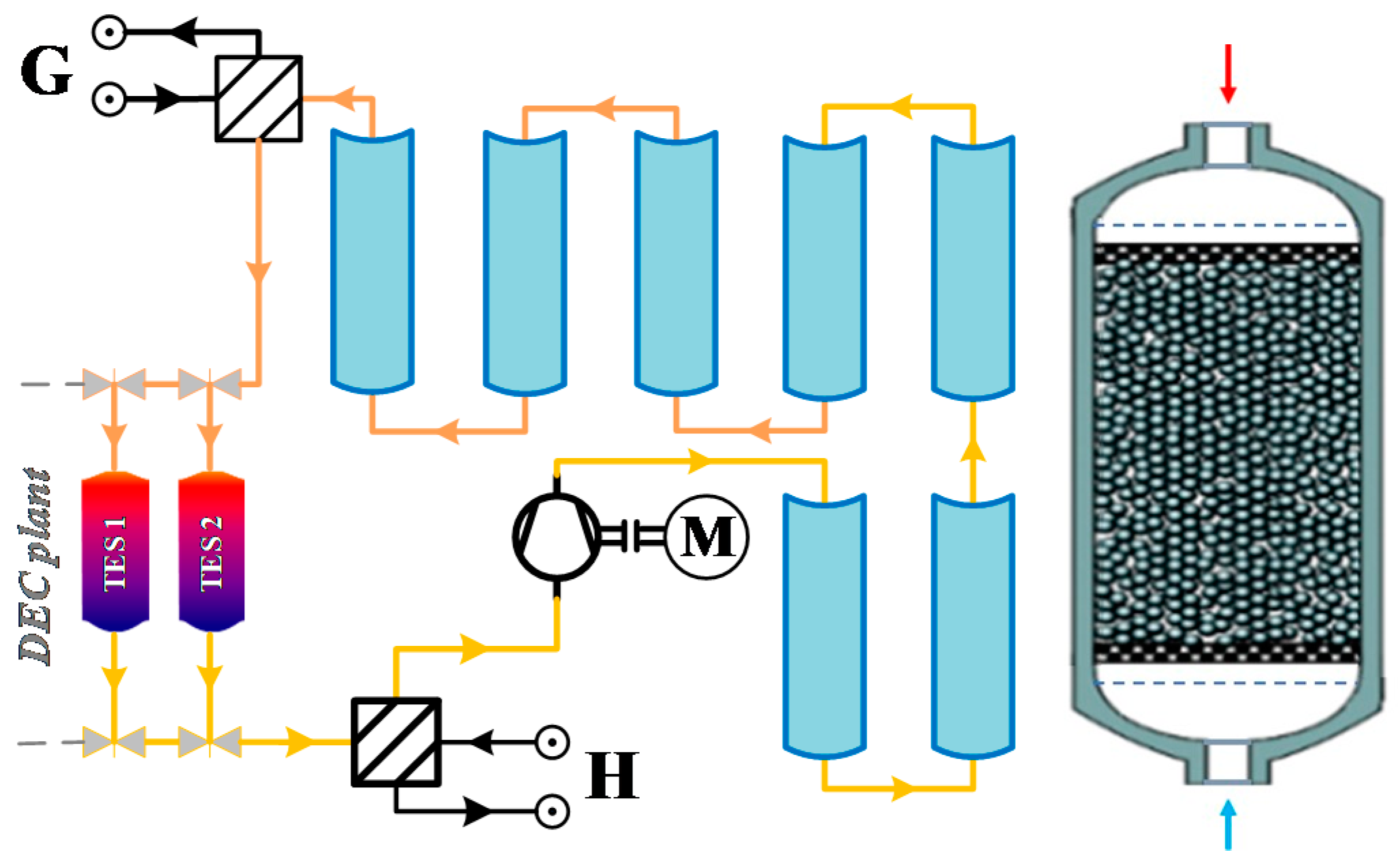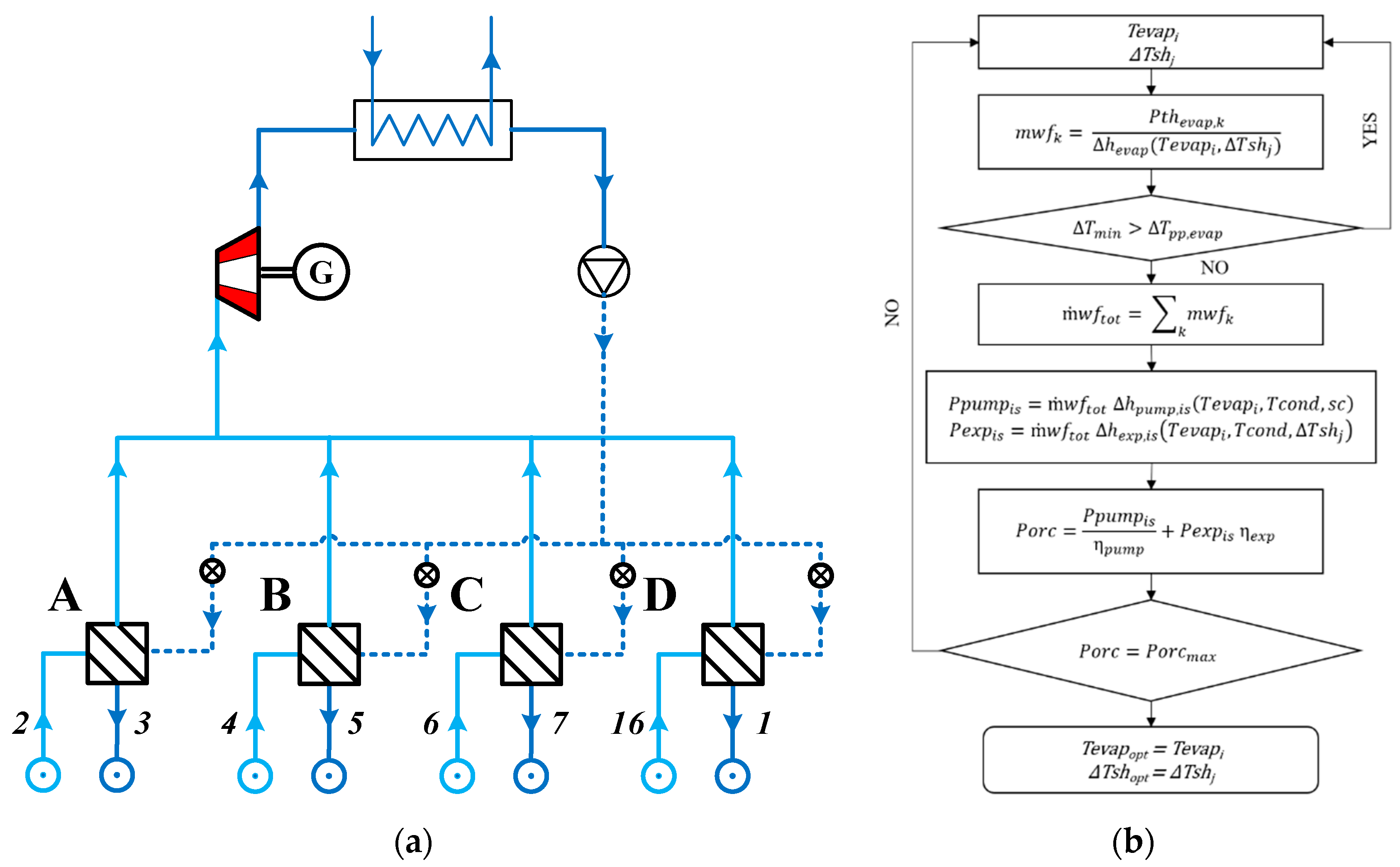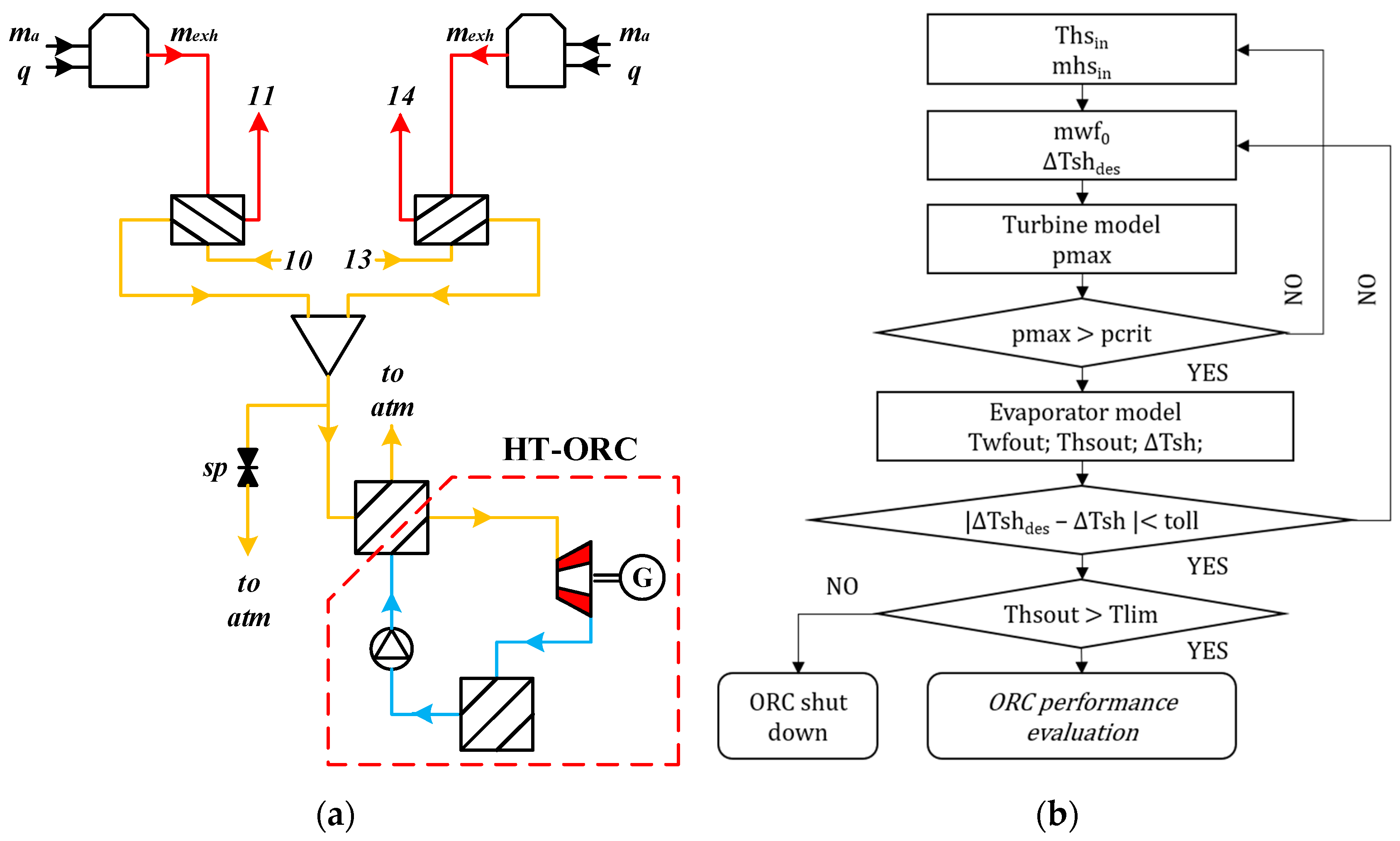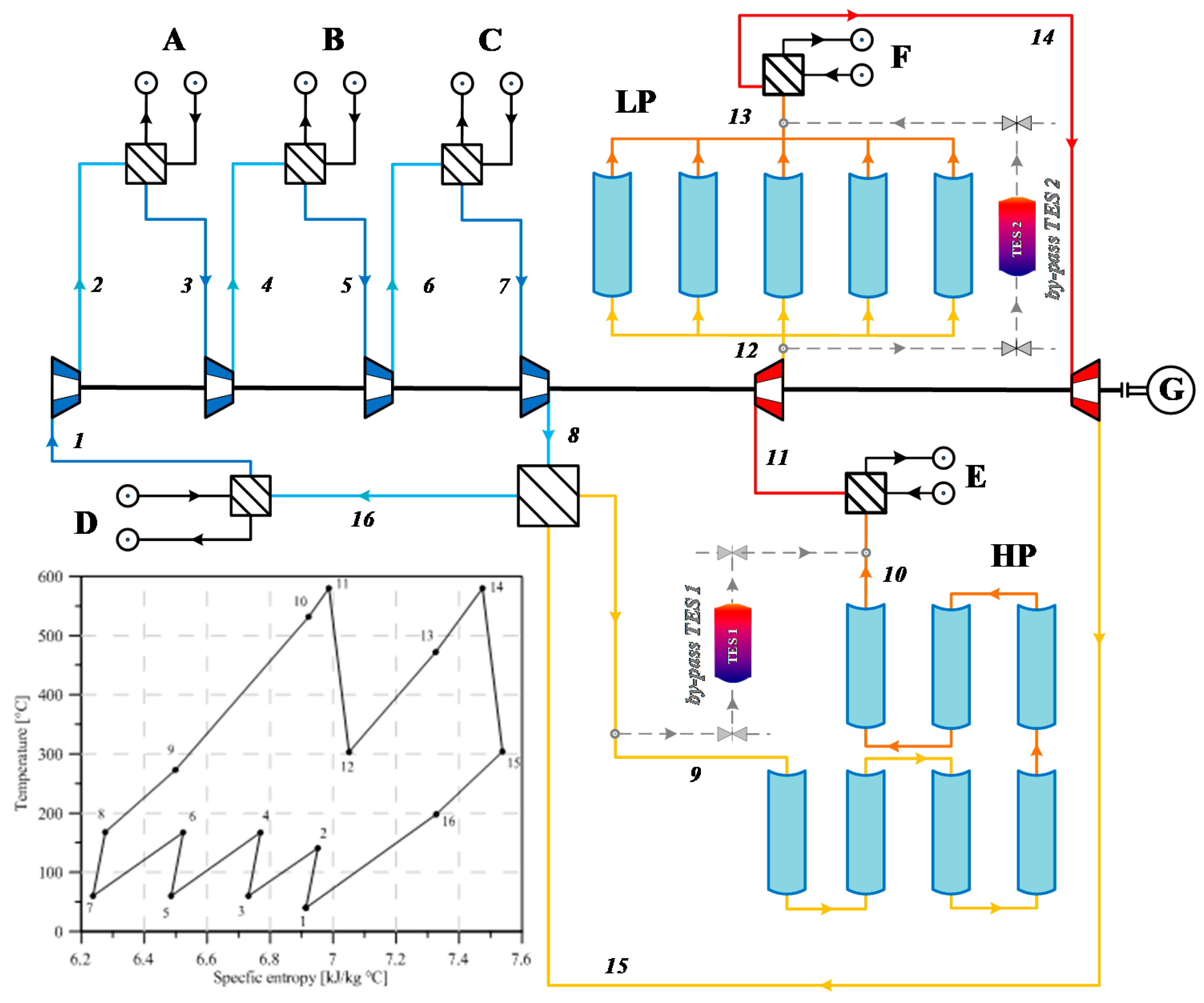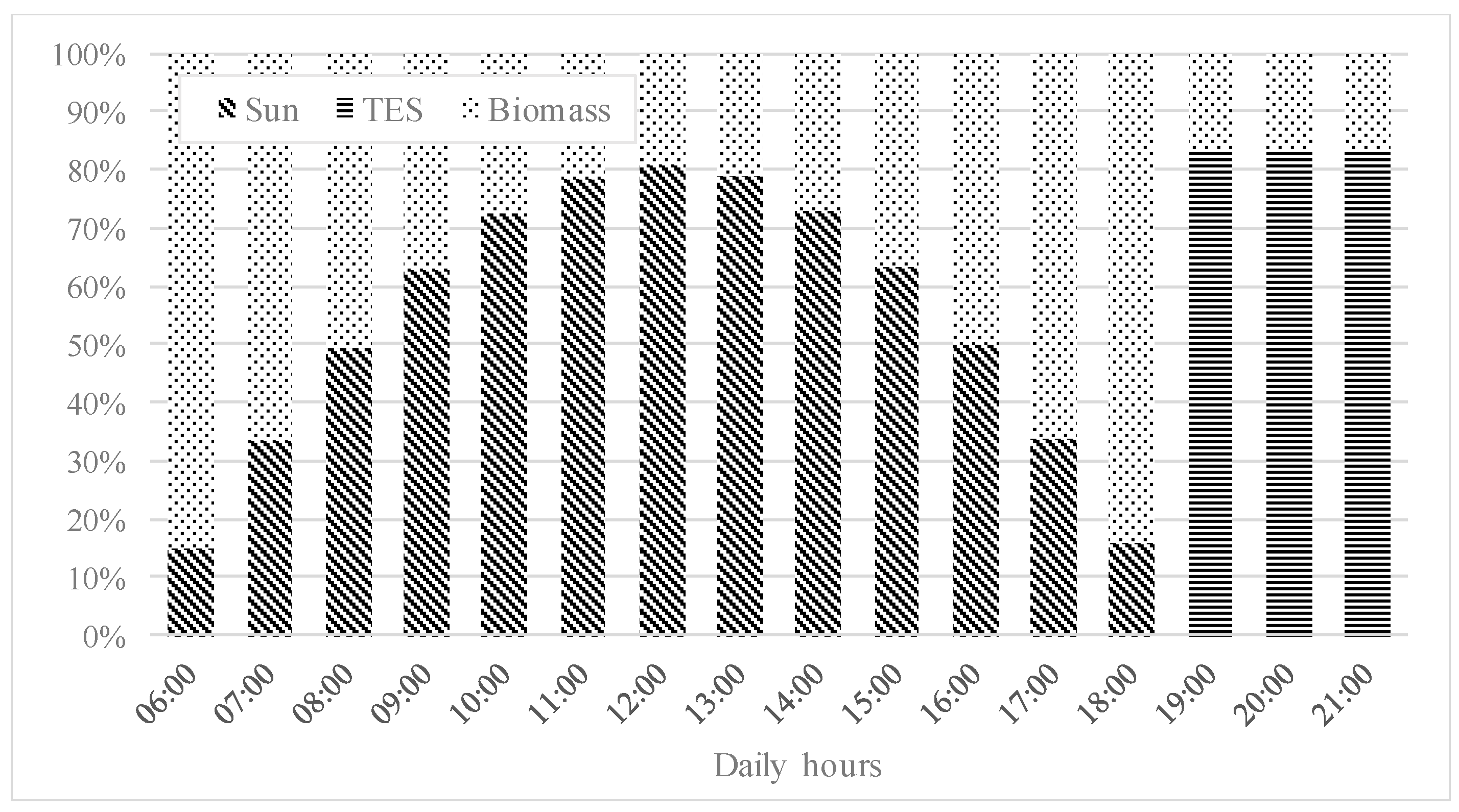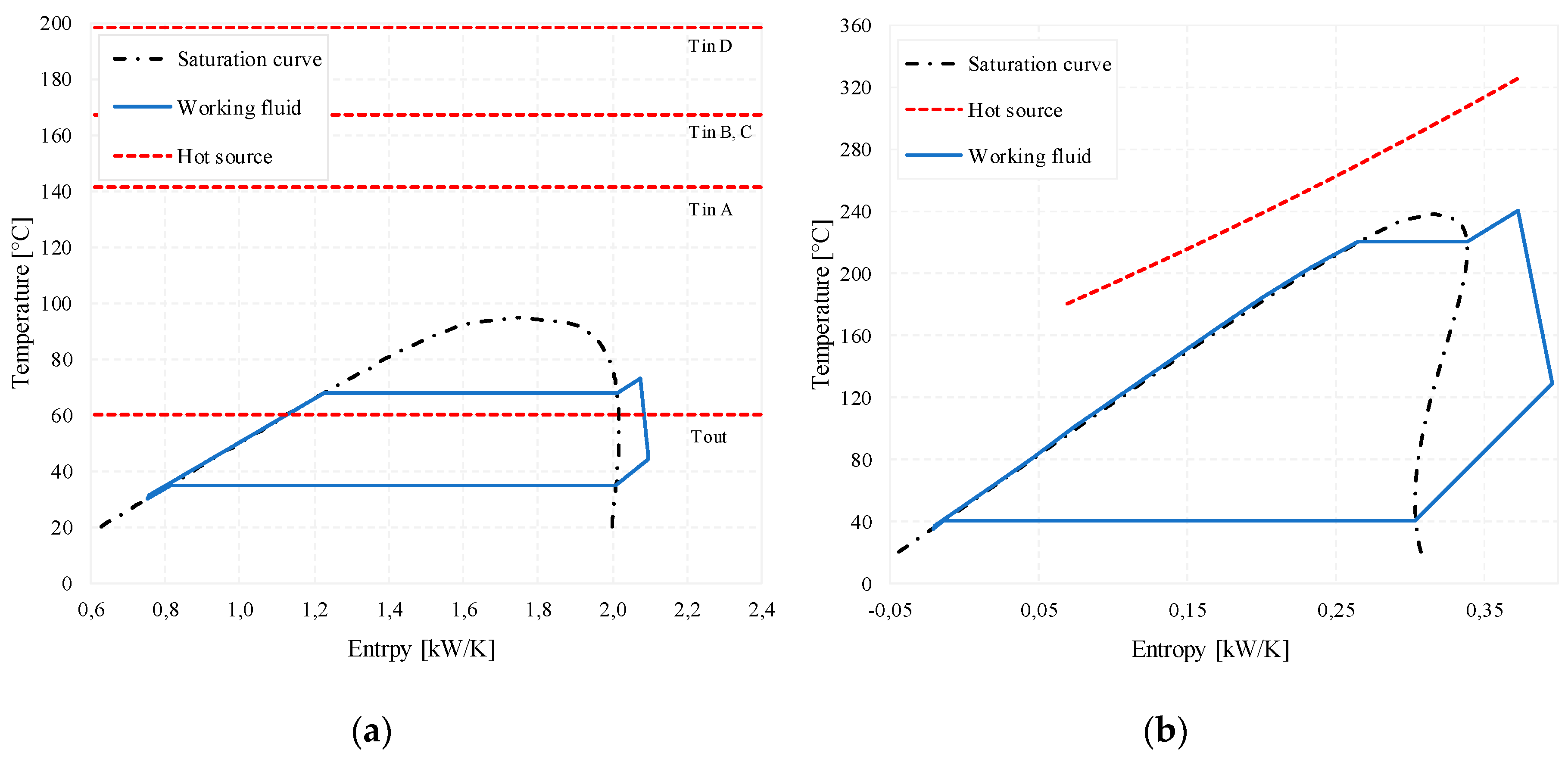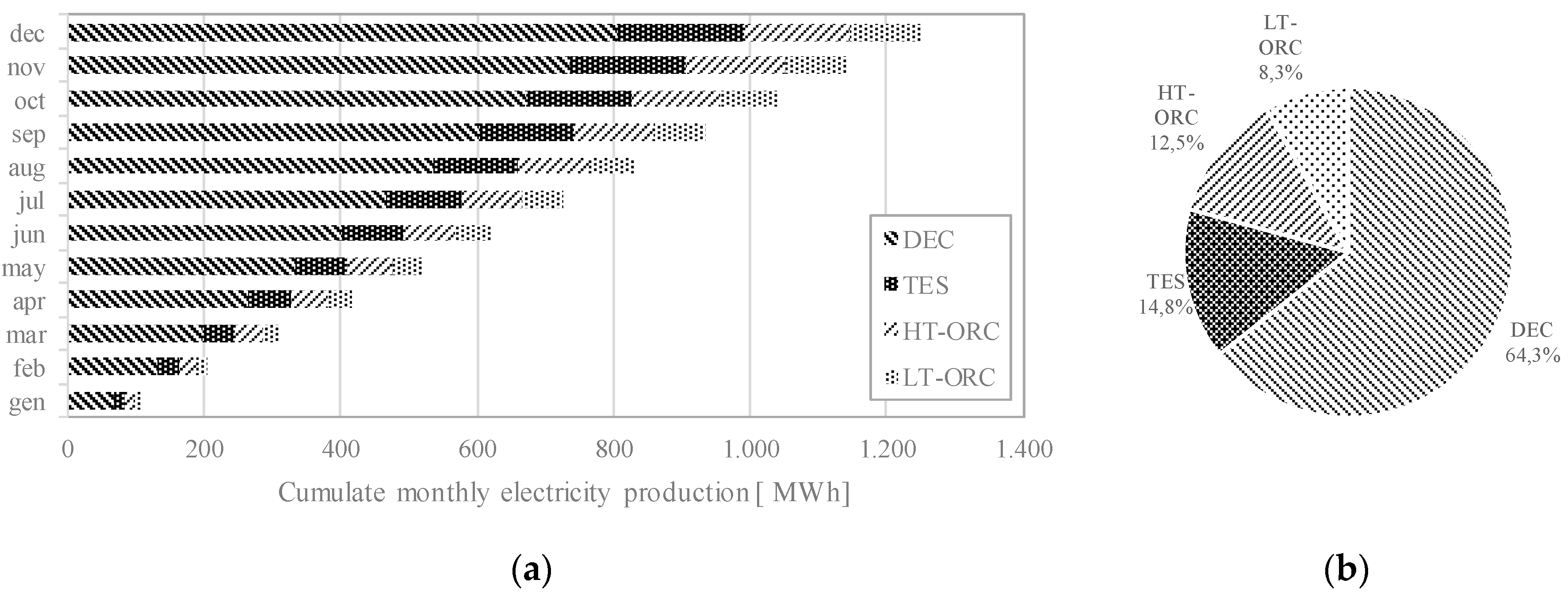4.1. Concentrated Solar Power Plant and Thermal Energy Storage Section
The system, optimized through the model described in previous sections, is represented in detail in
Figure 5, together with the thermodynamic transformations in the T-s plane. Maximum temperature and pressure were fixed at 580 °C and 30 bar, respectively, together with suitable values for the minimum temperature difference in the heat exchanger and component efficiencies. These design data match the present performances of the most relevant components, like receivers and maximum metal temperature, which could be compensated by the metal bellows between the metallic and the glass hoses. Air inlet temperature at the first compressor stage was 40 °C, at atmospheric pressure. Mass flowrate was fixed at 1 kg/s. The optimization model led to the definition of 4 compression stages and 2 expansions. This choice was a compromise between the incremental advantage on the net power produced and a reasonable design choice. The net power increased with the number of compressions and expansions, but the incremental advantage became less and less significant, when the number of machines increased. On the other hand, the management of an increased number of machines become more and more complex, also increasing the costs, as a result.
Figure 5 represents the thermodynamic cycle concerning the integration between compression section, regeneration, first heating, expansion section and re-heating. These parameters are expressed in
Table 4, including the absorbed heat, the produced power and the plant efficiency. These provided interesting values when compared with the existing technology for conventional CSP plants, which use oils and salts as HTF, i.e., net plant efficiency at 17.1%, (in line with 14–20% of PTC plants, [
11]). The thermodynamic data reported in
Figure 5 are the result of the calculation of the correspondent discrete Ericsson cycle with four optimized compressions (up to 30 bars as maximum pressure) and two expansions, assuming most relevant data (efficiencies of machines, pinch points, etc.). When a maximum temperature for the air as HTF is fixed (i.e., the thermal power that must be exchanged toward the compressed air) (thanks to the model of the solar receivers—Equations (1a–e), (2), and (3)), the overall length for each pressure level (after the compression and during the two expansions) can be calculated, increasing it till the data desired from the thermodynamic analysis is reached. In this sense, the overall modeling is used as design tool, by iterating it until the desired performances are reached.
The definition of the DEC layout and modeling and the sizing of all components, allowed us to simulate the plant electrical production and the operating conditions in a solar year, for any location, in order to quantify the different contributions (solar, biomass, TES), and potentially compare this production with that of a conventional CSP plant, using oils and salts as HTF.
The TES section is dimensioned in order to give 3 h of additional autonomy to the DEC plant, with the following parameters: 84 m solar plant with the same characteristics as that of the DEC, with a tank whose design is briefly presented in
Table 5, and charging and discharging phases, quantified in [
17,
28]. The charge of the two tanks is exerted at the same pressure, while the discharge is done at different ones. This aspect does not influence the discharging time, which still remains the same for both tanks. The 3 h capacity is allowed, as a result of the two charged tank that operates in parallel, each for every expansion section, for 6 h of total charging phase. For each tank, outlet temperature is about 270 °C and output temperature at 550 °C. Air mass flowrate can be increased, in order to achieve a shorter charging and discharging time. However, in this case, the solar collector length would be greater due to the need for splitting the flowrate in different solar receivers operating in parallel, when the air velocity tends to exceed the maximum allowable speed. In this case, the modeling reported in Equations (8) is also used as a design tool to get the desired time period of the additional continuous autonomy. After having chosen the most relevant parameters for the thermal energy storage (see data reported in
Table 5), the design found the height and the diameter of the thermal storage system, which fulfilled the two data referred to the energy accumulated (894 kWh and 815 kWh returned to the HTF).
Assuming the operation of the plant only when the solar source provides a sensible contribution (from 6.00 am to 18.00 pm) and the contribution of the TES section, the annual global energy production is evaluated for a specific location (Priolo Gargallo, in Sicily; the same location as that of the “Archimede” project, [
32]).
As an example, a daily percentage division of the different contributions is expressed in
Figure 6, for the 21st of June, in which, for the TES section and considering the best irradiation hours, the contribution of solar field was in an order of 44.2%, with a biomass at 40.1% and a TES section of 15.7%.
The annual percentage division of the same contributions is 67.5% of the biomass contribution and 32.3% of solar one, for a global energy production of 805 MWh/y for the DEC plant and a TES contribution of about 185.8 MWh/y.
The mathematical model relating to the PTC considers the monthly average daily radiation on a surface, with a given inclination and azimuth, using the UNI 8477-1 standard, [
33]. The result of the procedure returns an irradiation value extended to the period of one day and a monthly average, because the calculations refer to the day of the month, which has specific characteristics. The method is not based on the exact calculation of solar gains but on the measured values of ground radiation, of over a month, which is statistically more significant than the instantaneous values. Once the hourly irradiation factor is determined, for a given location and a given day of the year, it is possible to adapt the UNI 8477-1 standard to an hourly calculation, rather than a monthly average. To quantify the energy captured on a surface in a single day, it is necessary to consider the daily variation of extra-atmospheric radiation, the variation of the reciprocal position of the Earth–Sun and the specific meteorological conditions for that day—these steps are taken by considering the meteorological studies of Gordon and Reddy [
34], and the exponential model of Aguiar and Collares-Pereira [
35]. From these corrections, it is possible to obtain the direct hourly irradiation value.
4.2. Waste Heat Recovery Section
As aforementioned, the CSP plant with the storage system is able to produce a mean power of 170 kW, resulting in about 805 MWh of energy produced during the year, considering the variable radiation conditions. However, the WHR sections consisting of a low temperature, and a high temperature ORC system could increase its productivity, by utilizing the different heat sources that the CSP plant makes available.
Regarding the LT–ORC, different working fluids are considered (
Table 6) in the study, taking into account the thermodynamic and environmental performances.
Making reference to
Figure 3, the input parameter of the analysis, as well as the system constraints, are listed in
Table 7. The heat source is represented by the air exiting the compressors and the regenerator at temperature T
in A, T
in B,C, and T
in D, respectively.
Best performances are achieved with R1234yf, which allows the production of 23.5 kW of output power, showing an overall plant efficiency of the LT–ORC equal to 5.4%.
The high temperature waste heat recovery section instead is characterized by higher temperature levels of the heat source, determining the need for a higher critical temperature organic fluid that can recover thermal power more efficiently. For this reason, cyclopentane is considered, which had a critical temperature of 239 °C and a critical pressure of 45 bar. Design parameters are listed in
Table 7. T-s diagrams for the LT and HT–ORC at design conditions are presented in
Figure 7. A different representation is chosen for the heat source in the LT–ORC, since 4 different evaporators exist in the plant layout (
Figure 3). Inlet temperature and flowrate of the heat source at the design conditions correspond to the values obtained when the radiation is absent in the HT–ORC. In these conditions, in fact, much more thermal power is available because of the higher flowrate of exhaust gases needed to operate the CSP plant. The HT–ORC is able to recover 160 kW of thermal energy with an efficiency of around 20%, showing a power output equal to 30.7 kW.
Table 8 resumes the different characteristics of the different sections with the single energy production for each one.
Once defined, the design parameters that influence the behavior of the system at different input conditions, on a yearly analysis, is conducted. Given the nature of the LT–ORC system, it showed a flat contribution to the energy produced over the year, which topped at 103 MWh, representing almost 8.3% of the CSP energy production;
Figure 8. On the other hand, the HT–ORC system shows a variable contribution over the year. However, the chosen design point allows to limit the monthly produced energy oscillations below 20%, assuring a yearly energy production of about 157 MWh, which represents 12.5% of the CSP plant, in which, the main energy contribution is the DEC section, with 64.3% of energy production. The three-hour increase in operating hours assured by the TES system contributes to nearly 15% of the overall energy production.
